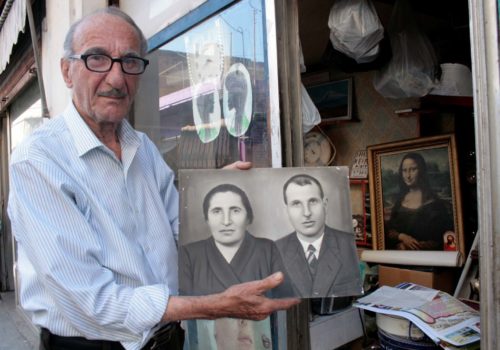What remains from Studio Joe, Beirut, Lebanon, is a set of about 30 pictures, portraits and self-portraits that would have disappeared without the attention of Roubina Margossian. A photographer based in Beirut, she was walking through Bourj Hammoud when she was attracted by an old man sitting in front of a shop covered with aging wall paper and literally stuffed with random paintings, photographs, newspapers, vinyl platters and other wrapped objects from another time. The window was pierce by a bullet hole.
As they started speaking, they realized that they shared a similar passion for photography and he promptly told her his rocambolesque story, one that brings together the history of photography with a romantic character. Born in the Armenian refugee camp of Qarantina, Beirut, after his father escaped from Turkey in 1924-25, Kevork Tashjian would soon be known as Joe – a surname given by his first lover that he kept as the only memory of her after she turned down his proposal. Pushed by his mother to find a job in order to support the family, Joe had accepted a position in a nearby optic shop. It was the time when merchants realized the great commercial potential of photography and initiated a trend called photo surprise. It was a common photographic practice in the Middle East between the 1940s and the 1960s, and was especially popular in Lebanon. Based in urban centers such as Beirut, Tripoli, and Istanbul, surpriseurs photographed pedestrians as they strolled streets. The subjects – some posing, others caught unaware – were handed cards with the photographer’s studio address and contact information so they could order prints. Walid Raad and Akram Zaatari – two contemporary Lebanese artists respectively co-founders of The Atlas Group and The Arab Image Foundation – recently popularized this practice by featuring old studio funds in several videos installations and publications.
Being Armenian, Joe had no religious restrictions to pictures and the shop owner took this opportunity to send him off in the streets with a camera to promote his shop. Shortly after, a photo studio owner noticed Joe’s talent and offered him a job. Fascinated by the beauty of the owner’s sister in law, Joe accepted gladly and promptly asked for her hand. As she refused, he quit his employer and opened his own photo studio in Bourj Hammoud, which he called Photo Joe. He earned his spurs as a portraitist and fortuitously followed the photographic experiences of the only renowned Arab studio in the region owned by the Armenian-Egyptian Van Leo, famous for his hand colored Hollywood-inspired portraits. At that period, photography was done by Westerners, with the rare exception of the brothers Abdullah during the Ottoman Empire. From the beginning of the discipline, explorers such as Giraud de Prangey, Carranza, Bachman, James Robertson, Sebah & Joaillier or Berggren had produced exotic images of the region and would be followed in the 30’s and 40’s by photographers like Lehnert & Landrock. Inspired only by his instinct, Joe colored many of his photographs and liked experimenting new techniques in self-portraits. Most of the remaining photographs in his collection are esthetically familiar self-portraits : dressed as an actor like in Van Leo’s famous portraits; in front of an antique building imitating explorer’s pictures; or with his family, in a traditional black and white studio photograph set-up. Even though, he never looked at other photographer’s work and had no clue of what others were doing in his field.
This series and a chance meeting him would change the course of his life as a photographer. While walking through the neighborhood, a famous Armenian singer known as Adiss Harmandian asked to have his portrait taken. He loved the result so much that he used it for his new album cover, which became a hit song in Armenian circles. They became good friends, sharing a common passion for music. The war raged in Lebanon and a bullet hit his studio, burning half of his negatives when the other half got soaked in water while he extinguished the fire. Joe was at that time in love with an Arab girl – the “love of his life”, of whom he still keeps a portrait – but his mother ran into the two of them and insulted the girl. She walked out and he never saw her again. After these unfortunate experiences and under the influence of his singer friend, he stopped photography and turned his studio into a music shop and focused on song writing. During this period, he wrote many of the songs performed by his famous friend and amassed a great collection of international hits. All these various treasures kept filling his shop until a few months ago, when he decided to sell it.
















